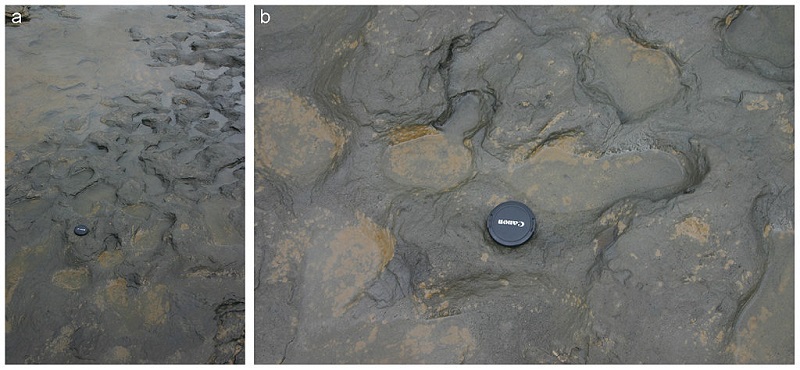In May 2013, storm waves eroded a section of the coastline at Happisburgh, a small village on the north-eastern coast of Norfolk. This unearthed a great archaeological discovery, of many sets of prehistoric footprint hollows imprinted into the clay. When the discovery was reported, a team of archaeologists lead by Simon Parfitt from the National History Museum rushed to the site. They took as many photographs, casts and sketches as they could within a short space of time. Two weeks after the footprints had been uncovered, they were eroded away by the tides, leaving only casts and 3D images as evidence.
Using pollen and the fossil remains of extinct animals, all of which were stored in the surrounding sediment, the footprints were dated to have been made around 900,000 years ago. This made them the earliest evidence of humans in Britain, and the oldest human footprints to be uncovered outside of Africa. Subsequent analysis showed that the prints belonged to at least five people, which included both adults and children. The clearest and best-preserved footprints showed a heel, an arch and four toes, with the fifth not being well-preserved.
The discovery confirmed that early humans, most likely from the species Homo antecessor, known more commonly as ‘Pioneer Man’, had lived at the northernmost zone of habitation in Europe around 900,000 years ago. Previously, at an archaeological site nearby, scientists had discovered fossilised animal bones and flint implements, which had been dated to a similar age. The discovery of the footprints confirmed that humans also lived in the same region during that time.
900,000 years ago, the climate was fairly similar to that of present Scandinavia, with short warm summers interspersed with long cold winters. The mud that the prints were preserved in would have formed the side of an estuary, probably an old course of the River Thames – hundreds of thousands of years ago, the river took a much more northerly course than it does today. At that time, the area was rich with prey animals, shellfish and edible plants – it is likely that the group was scavenging for food. However, human activity in the area was limited by future climate-related fluctuations. 50,000 years later, north-west Europe became significantly colder, forcing humans to leave what is now eastern England, and retreat southwards into continental Europe across a land bridge.
The footprints therefore provide a rare snapshot into human activity in eastern England, at that particular time in history. This discovery is, however, thought to be the tip of the iceberg, with many more footprints and possible human fossils thought to exist in the area, just waiting to be unearthed by future cliff erosion. In 2019, five more footprints from the same era were discovered at Happisburgh, only to be measured by archaeologists and then lost to the waves. This is a very erosive stretch of coastline, meaning that future discoveries may not be too far away.
References
https://www.nhm.ac.uk/discover/the-oldest-human-footprints-in-europe.html
https://www.theguardian.com/science/2014/feb/07/oldest-human-footprints-happisburgh-norfolk
https://www.northnorfolknews.co.uk/news/discovery-of-new-happisburgh-footprints-announced-at-deep-history-coast-1638288
Image: Martin Bates, CC BY 4.0, via Wikimedia Commons

